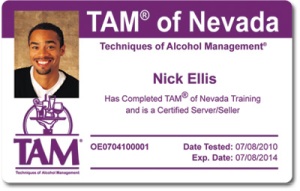 Did you know that according to a new report from National Center on Addiction and Substance Abuse (CASA) at Columbia University, about 50% of high school students smoke, drink alcohol or use drugs? (WebMD). The sheer number of teenagers who are experimenting with these substances is alarming, and even more alarming is the likelihood that many of them will become addicted. TAM® Card Holders and hospitality professionals are often the first line defense against underage access to teen drinking. Are you doing everything you can to help prevent teenage drinking?
Did you know that according to a new report from National Center on Addiction and Substance Abuse (CASA) at Columbia University, about 50% of high school students smoke, drink alcohol or use drugs? (WebMD). The sheer number of teenagers who are experimenting with these substances is alarming, and even more alarming is the likelihood that many of them will become addicted. TAM® Card Holders and hospitality professionals are often the first line defense against underage access to teen drinking. Are you doing everything you can to help prevent teenage drinking?
Retailers and off-site sales professionals should be diligent about checking IDs as well to make sure teenagers are not trying to purchase liquor with fake or borrowed identification. To learn more about recognizing a fake or borrowed ID, refer to our blog post, “Are Minors Using Fake IDs and Sneaking Past You?” Most establishments also have a guidebook, like the I.D. Checking Guide, for validating various forms of identification. Ask your manager if you have a guide like this in your establishment and refer to it if needed. The I.D. Checking Guide can be purchased from TAM® here.
In addition to diligently checking identification, there are some other easy steps one can take in both retail and on-site establishments to help prevent teen access to alcoholic beverages such as storing alcoholic and non-alcoholic beverages in separate display cases, making sure containers are labeled clearly and properly, and double checking that your guests are being served exactly what they ordered in on-site establishments. For more ways to help curb teens’ access to alcohol, refer to We Don’t Serve Teens’ suggestions.
What policies have you instituted at your organization to deter teen drinking?
Resources
Nearly Half of U.S. Teens Smoke, Drink Alcohol, or Use Drugs – WebMD Health News
Stopping Teens’ Easy Access To Alcohol – We Don’t Serve Teens
© 2011 National Hospitality Institute®, TAM® of Nevada

 Often imitated, never duplicated, TAM® of Nevada has been the sole provider of official TAM® Cards to the Las Vegas community for over 25 years. There are several providers of credible and effective alcohol awareness training and drink cards, but TAM® of Nevada is the only authorized provider of the official TAM® card. Also, more employers recommend TAM® of Nevada for their employees’ alcohol education than any other provider. Wonder why? You can learn more about what sets TAM® of Nevada apart and makes our training unique
Often imitated, never duplicated, TAM® of Nevada has been the sole provider of official TAM® Cards to the Las Vegas community for over 25 years. There are several providers of credible and effective alcohol awareness training and drink cards, but TAM® of Nevada is the only authorized provider of the official TAM® card. Also, more employers recommend TAM® of Nevada for their employees’ alcohol education than any other provider. Wonder why? You can learn more about what sets TAM® of Nevada apart and makes our training unique 